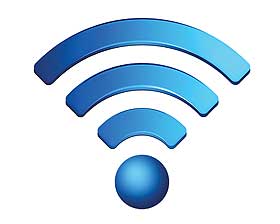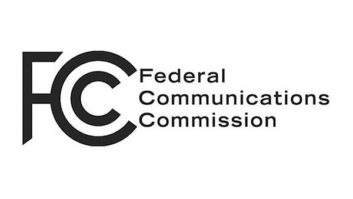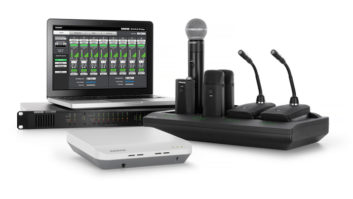
“Ninety percent of wireless users will likely see no difference,” says Lectrosonics’ Karl Winkler, in reference to the September 2010 decision by the FCC to open up portions of the broadcast spectrum to “white spaces devices,” meaning new portable consumer gadgets and the coming enhanced Wi-Fi networks being pushed by companies such as Google, Dell and Microsoft. “For typical wireless users,” Winkler continues, “those who run fewer than 16 channels in a fixed installation where the mics are in close, they should be fine. But if you go out to the edge with a large number of channels that are unregistered in a crowded market, you could find yourself in trouble.”
What’s he talking about? In some circles, the unanimous September 23 decision was front-page news. That ruling was two years in the making, following a 2008 announcement that the largest allocation of wireless spectrum in 25 years would be opened up to unlicensed use. The NAB petitioned vehemently to prevent the ruling, arguing that by allowing unlicensed, low-power users unfettered access to the broadcast spectrum, TV stations and news gatherers would be in constant jeopardy from interference. Wireless microphone manufacturers, most notably Shure, also chimed in, spending millions of dollars and enlisting the support of Illinois Representative Bobby Rush, Nevada Representative Shelly Berkley and others to lobby on behalf of the professional wireless community. Imagine, they argued, countless local Wi-Fi hot spots and thousands of active SmartPhones at a headlining concert in Minneapolis, or a political rally in D.C., or an unscheduled media event in Times Square, right in the heart of
Broadway—dropouts, interference, signal stomping, even from low-power devices.
It was an argument that nobody was going to win. NBC against Google? ABC/Disney/ESPN against Microsoft? Shure, Sennheiser and Lectrosonics against Dell? Consumers want the access and the speed, the latters argued. Consumers want clarity and reliability argued the former. But after the dust settled (and the bloggers chimed in), it seems that, yes, the high-tech community won big, with unused white spaces—the high-quality broadcast spectrum freed up with the 2009 conversion to digital television—opened up to unlicensed use for low-power devices. And, yes, the FCC acknowledged the professional audio community, even if it was in a limited way.
A COMPLEX SOLUTION
In a nutshell, wireless microphone users were granted a protected part of the spectrum, so in that sense it was a victory. On a market-by-market basis, wireless mic users are protected in the two first-available channels above and below or closest to TV 37 (the protected radio astronomy band), but it might be 36-38 in one market and 35-36 in another. So it is incumbent on the operator to dial in what is what. If a local user or a touring act has a special event requiring more channels or greater protection, they are able to apply to the FCC for a “protection extension” with a 30-day advance that includes a period of public comment.
The problem right now is that it is not clear what guidelines will govern the application approval; nor has it been determined who, or what, will maintain a national database of licensed users that will be the primary source of protection for larger, fixed operators. The FCC left that decision for later. Google, and other consumer-oriented groups, have applied to be the administrator of the database, but more than one commentator has equated that to the fox guarding the henhouse.
Also, the FCC did not follow through on one of the key proposals from 2008 that would require unlicensed operators to employ sensing technology in every unit. That means your 4G PDA, tablet or phone doesn’t have to check for unused frequencies and switch over when in conflict; it would have been too expensive per device, the consumer group argued. The FCC did, however, keep a provision from 2008 that requires geolocation technology in all unlicensed devices, meaning that they have to check in with the database of known broadcasters and wireless mic channels that have registered for protection, either temporary or permanent.
Nobody Mix has talked to during the past few months has expressed much worry about the Super Bowl or the Grammys, the 17,000-member congregation or Universal Studios theme park, the Bon Jovi tour or Bonnaroo. They will register; they will be protected. But problems may crop up with the mid-level act coming into Las Vegas without a tech-savvy production manager, or the 500-person congregation that has a mega-Easter production with guest actors and a full-blown, all-in-ears backing band. Is it the musical director’s job to register? Or is it the head of the regional sound company who rented the extra transmitters, beltpacks and antennae? These are the questions that can be headed off by those who look ahead, but as we all know in live sound, even the best laid plans…
THE STATUS QUO—FOR NOW
But the sky is not falling, as Winkler points out, a sentiment echoed by Mark Brunner at Shure. “The FCC ultimately listened to the needs of the professional wireless community and set aside two UHF channels to protect the majority of users,” Brunner explains. “That is a victory. The FCC recognized our needs. But there is more to come, and every wireless user, big and small, needs to pay attention over the coming year. We still don’t know who will be maintaining the national geolocation database, so getting registered—especially for the mid-level church, event production or regional theater—is critical. We are encouraging all of our users that if in doubt, apply for a license!”
“This is not equivalent to two years ago, when we were told that we had to vacate the 700MHz band,” Winkler concludes. “That involved new products, updates and changeovers. This is part of an evolution, of the eroding of the wireless spectrum. Most people should be okay, but everybody needs to pay attention.”



